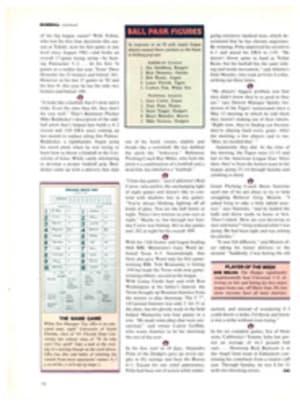
OVER HILL, DALE AND POTHOLE, THESE MOUNTAIN BIKES GO ROLLING ALONG
Bicycle people call them klunkers, which certainly seems fair and accurate enough. These strange bikes do look pretty klunky at first glance: They've got fat, knobby tires and upright, straight handlebars. It's only at second or third glance that a kind of hidden beauty starts to shine through, and after a few moments of riding, one begins to experience some gentle stirrings just behind the rib cage. This condition is known as love at first flight.
These critters are properly called mountain bikes or off-road bikes, though neither name does them justice. They might just as well be called gravel-road bikes, or grassy-meadow bikes, or muddy-pothole-riddled-street bikes—and it's gradually becoming known that, in low gear, one could pedal a klunker up the north face of the Chrysler Building. It isn't quite as well known that the bikes also can be ridden up and down stairways. One model, built by Specialized Bicycles of California, is called the StumpJumper, and that just about says it all. One manufacturer sees the klunkers as city bikes of the future, suitable for rattling across subway gratings, manhole covers and streetcar tracks. And as more performance reports roll in, it's possible to see a national craze taking shape during the course of 1983.
This is assuredly not a scoop in the traditional sense; certain klunkers have been circling on the far edge of our vision for years, called, variously, cruisers or beach bikes. This is more an update, since it's the refinement of those fat-tired bicycles that's causing the stir these days. Enthusiasts wanted the same quality in their off-road bikes that they have in their racing bikes, and they wanted durability as well. No less an authority than Bicycling magazine has road-tested nine brands of off-road bikes, bashing them about very earnestly indeed, and Senior Editor John Schubert wrote, "All this leads me to a startling conclusion: I predict klunkers will overtake dropped-handlebar 10-speeds as America's favorite bicycles just as soon as enough manufacturers make them available in appropriate quantities and price levels."
Which is exactly what's now happening. What Schubert and other experts are talking about is a sophisticated contraption offering lightweight chrome-moly frames with long wheelbases to suit rough conditions. Bottom brackets are higher, about 12 inches; chain-stays are longer, 18 inches, and the clincher: New skinwall balloon tires and aluminum-alloy rims trim the weight of old blackwall tires and steel rims by more than six pounds. The result is a lively bike of about 28 or 29 pounds, as light as many 10-speeds. Sealed bearings keep mud and water out of vital parts. Most mountain bikes have easy-grab motorcycle brake levers and cantilevered brakes that could stop a runaway truck, and gearing is much lower than on a normal touring bike—so low that the grade one can climb is limited only by the ability of the rider to balance the bike. Handlebars are up and straight, and—here's the luxurious part—the gear shifters are thumb levers mounted on the handlebars. One can flick easily through 15 gears; no more taking one hand away from the bars and leaning forward to shift a gear lever on the frame.
Suddenly just going fast on a lightweight bike isn't enough anymore—what counts is going any place you want. "Skinny-tire chauvinists figure they're not supposed to like these things," says Schubert, "but they ride them and love them." On the West Coast, particularly around Marin County, cradle of the fattire movement, cyclists are swarming into the hills. In southern Utah's Canyonlands National Park, a band of riders touring last year on conventional 10-speeds parked their bikes alongside the highway and walked up a treacherous, narrow hiking path, in some spots skirting patches of loose shale. They emerged on top of a high mesa overlooking the park. There sat Eric Miller, 22, of Salt Lake City and a gang of his pals—all of whom had ridden their klunkers up. Miller knows how the bikes are meant to be used, and he constantly takes his to the limit: He rides it both ways on staircases, across rocky streambeds and over small walls. He may also have the only klunker around with fenders—a defensive measure. "They make my bike look particularly stupid," he says. "But I've discovered that people don't steal bikes that have fenders; they glance at them and think they're cheap and go for the 10-speeds instead."
Miller's pal, John O'Brien of Fisher's Cyclery in Salt Lake, put together a klunker as a gift for his girl friend, Stephanie Gerbasi—and so many customers leap on it when it's parked inside the shop that he figures he could probably make a living custom-building the things. "It's great fun to actually look for bumps and dips in the streets," says Gerbasi, "or to peel off the road and follow a narrow trail through the woods." Says O'Brien, "The idea is that you can take a high-quality bike like this and actually abuse it and not hurt it."
In the East, Tom Franges, a management consultant for Fuji America in New Jersey, says forget off-road terrain, "we see klunkers as the perfect city bike. Klunkers can handle any hazard on city streets, and they're light enough to be picked up and carried up to your apartment. They're the commuter bike of tomorrow." Fuji showed off a prototype at last fall's Interbike Show in Las Vegas and, on the basis of receiving an enthusiastic response, decided to produce 800 klunkers this year and 1,000 in the coming year.
Other builders are gearing up, so to speak, for the coming craze, and advance information indicates that this year's prices will range from $350 to $750 or so, increasing as one piles on the extras. Univega is more than tripling production, from 3% to 10% of its total output. The new bikes have their own name. ATB, for All-Terrain-Bike, says Bernie Kotlier, sales manager for Ben Olken Co., Univega's Northeast distributor. There are now eight models in the new line, and a promotional campaign has been built around the bikes.
But perhaps the surest sign of the future came last summer at the fifth annual Snowbird Lowenbrau Hillclimb, a tortuous 10.2-mile race up Little Cottonwood Canyon to the Snowbird ski resort above Salt Lake City. There were 310 riders and bikes of all breeds, almost all of them super lightweights with skinny tires. But there in the pack were two mountain bikes. On the toughest parts of the canyon road, after the racing-bike riders went by standing on their pedals, all curled over their turned-down handlebars, along came those klunkers in their superlow gears. The riders were sitting comfortably, not laboring. Of course they weren't going as fast, and of course they didn't win. But getting there was at least half the fun.

